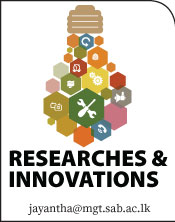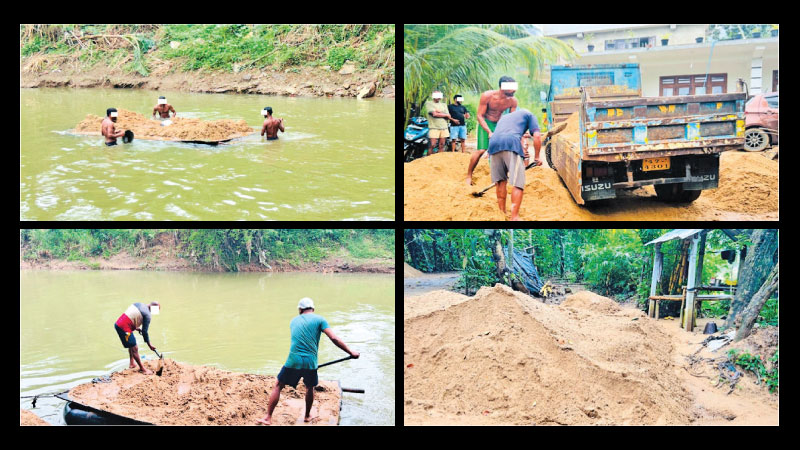 Sand mining has long been a cornerstone of Sri Lanka’s construction industry, providing essential raw materials for urban development. The country’s construction sector demands approximately 12 million cubic meters of sand annually (by 2024), with an estimated growth rate of 10%.
Sand mining has long been a cornerstone of Sri Lanka’s construction industry, providing essential raw materials for urban development. The country’s construction sector demands approximately 12 million cubic meters of sand annually (by 2024), with an estimated growth rate of 10%.
This soaring demand has driven the rapid expansion of sand mining operations, particularly in regions like Badulla, where extraction has intensified over the last two decades. The industry provides direct employment to thousands of individuals, including an estimated 15,000 licensed sand miners and an unknown number of unregulated workers. In financial terms, the sand trade contributes billions of rupees to the local economy, with market prices for construction sand rising fourfold over the past decade due to supply constraints and increasing demand.
The objectives of this research study include analysing the financial viability of sand extraction, evaluating its contribution to local livelihoods, identifying the scale and severity of environmental damage, and reviewing the effectiveness of existing policies in mitigating adverse effects.
Badulu Oya was selected due to its prominence as a central sand mining hub in Sri Lanka. The region has experienced significant growth in mining activities over the past two decades, supplying a substantial portion of construction sand to nearby urban centers. Additionally, the socioeconomic dynamics of the area, where a large segment of the population depends on sand mining for income, present a unique case study for balancing economic necessities with environmental conservation.
However, while the financial benefits are undeniable, the ecological and regulatory challenges surrounding sand extraction raise serious concerns about its long-term sustainability. Excessive extraction has resulted in the degradation of riverbanks, the destruction of aquatic ecosystems, and increased flooding risks.
Experts warn that without proper regulation, some rivers may deplete their sand reserves within the next few decades, leading to severe ecological and economic consequences. The balance between sustaining livelihoods and ensuring environmental conservation has become increasingly tricky, placing pressure on policymakers and local communities to find viable solutions.
Methodology of the study
This study employed a qualitative research approach, incorporating in-depth interviews with mine owners, workers, truck drivers, and regulatory authorities in the Badulu Oya region. A purposive sampling method was used to ensure diverse perspectives were captured. Data collection included direct observations and semi-structured interviews, allowing for a comprehensive understanding of socioeconomic, financial, and environmental impacts. Thematic analysis was applied to identify key trends, while official reports and regulatory documents were reviewed to assess the effectiveness of current policies. The findings provide a holistic view of sand-mining practices and their implications for sustainability.
Economic benefits vs. environmental costs
For many residents of the Badulu Oya region, sand mining is more than just an industry—it is a means of survival. Its employment supports mine owners, workers, truck drivers, and local businesses. With an initial investment as low as 50,000 Sri Lankan rupees, starting a sand mining operation is relatively accessible. The high demand for construction sand and increasing land development has made it a lucrative venture. Yet, the same industry providing economic stability also inflicts significant environmental damage.
Unregulated sand mining has led to riverbank erosion, habitat destruction, and water pollution. The excessive removal of sand disrupts natural sedimentation patterns, weakens infrastructure such as bridges and roads, and contributes to declining water quality.
Furthermore, sand mining intensifies flooding risks, making nearby communities vulnerable to natural disasters. In some areas, entire riverbanks have collapsed, leading to displacement of families and agricultural land loss. Fishermen, once reliant on these water bodies, are witnessing declining fish populations due to habitat destruction.
The role of regulation
The Geological Survey and Mines Bureau (GSMB) and the Central Environmental Authority (CEA) have been crucial in regulating sand mining in Sri Lanka. Their efforts in implementing licensing requirements, designating extraction zones, and enforcing compliance have significantly contributed to sustainable resource management.
Over the years, improvements in monitoring mechanisms and stricter permit regulations have helped control excessive mining activities, mitigating some of the environmental risks associated with unregulated extraction. However, enforcement remains challenging due to the vast scope of mining operations and the difficulties in on-ground monitoring.
While unauthorised mining still occurs, it is essential to recognise that most legal miners operate within the framework set by the GSMB and CEA, following best practices to minimise ecological harm. Delays in permit issuance remain a concern, with some miners reporting waiting periods of up to three months, affecting their operational efficiency.
The Government has also introduced penalties to curb illegal mining, and continuous efforts are being made to enhance regulatory oversight through community engagement and technological advancements.
The human side of sand mining
Behind the statistics and regulations lie the stories of those who depend on sand mining for their daily income. Unlike other family-run businesses, most sand miners in Badulu Oya did not inherit their work but instead entered the trade out of economic necessity. For many, it is their primary source of income, supplemented by side jobs like operating heavy machinery or running small businesses.
Workers endure harsh conditions, diving into cold water for hours to extract sand. The work is physically demanding, with injuries from submerged debris being common. Environmental pollution, including waste from municipal councils and butcher shops, has also worsened working conditions.
In some cases, polluted water forces miners to halt operations temporarily, cutting their earnings. Many miners have developed chronic health issues due to prolonged exposure to contaminated water and extreme physical exertion. The absence of safety equipment and medical support further exacerbates the risks faced by workers in the industry.
Striking a balance
Despite its challenges, sustainable sand mining is not an impossible goal. There are ways to balance economic necessity with environmental responsibility. Best practices include regulated extraction limits, riverbank restoration efforts, and community engagement in conservation projects.
Mine owners have expressed willingness to pay higher royalties in exchange for increased extraction rights, indicating a potential pathway for revenue generation to fund environmental restoration. Investment in alternative building materials could also alleviate pressure on natural sand reserves. Encouraging recycled construction materials and promoting responsible mining techniques would reduce long-term ecological harm while maintaining the industry’s economic viability.
Additionally, authorities must prioritise the restoration of degraded riverbanks through afforestation projects and strict replanting guidelines. Collaboration between local communities and environmental agencies can lead to the development of sustainable mining models that minimise damage while maintaining employment opportunities.
Conclusion
The sand-mining industry in Badulu Oya is at a crossroads. While it provides essential employment and supports the local economy, its environmental impact cannot be ignored. Strengthening enforcement mechanisms, streamlining permit processes, and investing in sustainable practices are critical to ensure that sand mining remains viable without compromising the region’s ecological balance.
Integrating technology, such as satellite monitoring and GPS tracking of extraction activities, can improve oversight and transparency in the industry. For Sri Lanka to achieve sustainable development, it must balance economic growth and environmental stewardship. A holistic approach, incorporating stricter enforcement, alternative resources, and community-driven conservation efforts, will ensure that sand mining remains an asset rather than a threat to the region’s future.
By Ms. Sithumini Gunawardhana, Dr. Nimila Dushyantha, Ms. Gimhani Nipunika, Mr. Panchala Weerakoon, and Dr. Titus CoorayUva Wellassa University of Sri Lanka , Ms. Sandunika Rathnayake and Dr. Gayithri Niluka Kuruppu, University of Moratuwa





